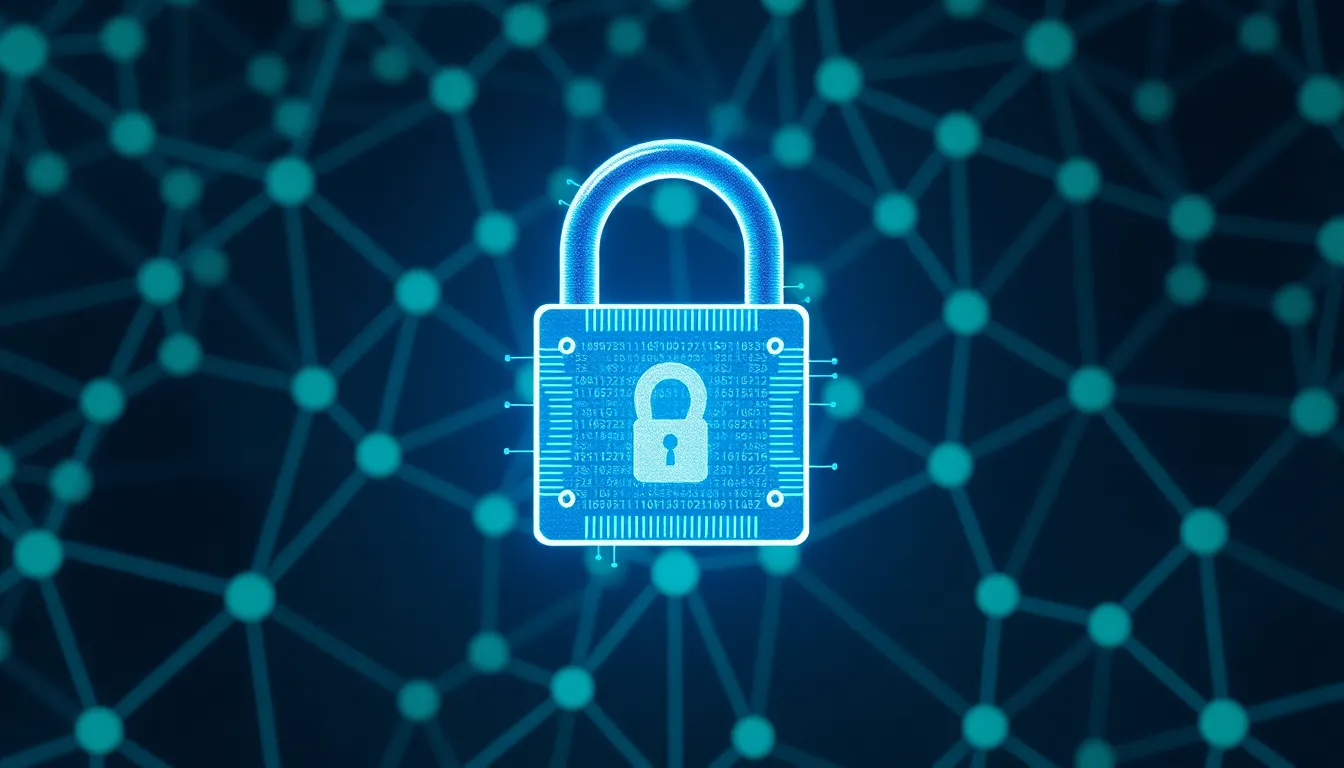In a world where cyber threats lurk around every digital corner, blockchain security stands as the superhero of the tech realm. Imagine a fortress where data is locked tighter than a drum, and only the right keys can unlock its secrets. That’s the magic of blockchain—offering a level of security that makes hackers rethink their life choices.
But don’t be fooled; not all blockchains are created equal. Some are like that one friend who always forgets their wallet at dinner, while others are the fortress of solitude. Understanding how to navigate this landscape is crucial for businesses and individuals alike. So buckle up as we dive into the wild world of blockchain security, where protection meets innovation, and the stakes are higher than your morning coffee.
Table of Contents
ToggleOverview of Blockchain Security
Blockchain security plays a crucial role in protecting digital transactions and data integrity. It employs cryptographic techniques to secure information across distributed networks. This technology ensures that data remains tamper-proof through consensus mechanisms that require agreement from multiple parties before any changes occur.
Notably, the decentralized nature of blockchain minimizes single points of failure. Transactions undergo validation by a network of nodes, enhancing security and reducing the likelihood of unauthorized modifications. Various blockchain types, including public and private blockchains, present different levels of security features. Public blockchains, like Bitcoin, offer transparency but may expose users to potential attacks, while private blockchains provide more controlled access but can be susceptible to insider threats.
Smart contracts, programmable agreements executed on blockchain, raise the stakes for security. Developers must rigorously test these contracts to prevent vulnerabilities. Auditing smart contracts becomes essential, as even minor flaws can lead to significant financial losses.
Cybersecurity threats, including 51% attacks and Sybil attacks, challenge blockchain systems. In a 51% attack, an entity controlling more than half of the network’s hashing power can manipulate transactions. Sybil attacks involve a single actor creating multiple false identities to dominate the network.
Ongoing advancements in blockchain security focus on enhancing encryption methods and developing innovative consensus algorithms. Organizations adopting blockchain technology can benefit from implementing robust security measures, conducting regular audits, and educating users about best practices.
Blockchain security is not just a technical concern; it encompasses user behavior and practices. Stakeholders must prioritize security alongside efficiency to navigate the digital landscape effectively.
Key Concepts in Blockchain Security

Blockchain security relies on several foundational elements that work together to ensure data integrity and protection against threats. These elements play a crucial role in securing digital transactions and maintaining the trustworthiness of the blockchain.
Cryptography in Blockchain
Cryptography forms the backbone of blockchain security. It ensures data confidentiality through encryption techniques. Public and private keys facilitate secure transaction verification between parties. Each transaction generates a unique cryptographic hash, linking each block to its predecessor. This linkage prevents unauthorized alterations, maintaining the integrity of the blockchain. As a result, robust cryptographic protocols fortify the security of sensitive information against unauthorized access and cyber threats.
Consensus Mechanisms
Consensus mechanisms determine how transactions are validated within a blockchain network. Various mechanisms exist such as Proof of Work and Proof of Stake, each with unique advantages. They align nodes in a decentralized system, ensuring that all parties agree on transaction legitimacy. Proof of Work requires nodes to solve complex mathematical problems, while Proof of Stake relies on stakeholders to validate transactions based on their holdings. These mechanisms not only enhance security but also minimize the risk of malicious attacks, fostering trust among participants in the network.
Common Vulnerabilities in Blockchain
Understanding vulnerabilities within blockchain systems is essential for maintaining security. Both smart contract flaws and network attacks pose significant risks to blockchain integrity.
Smart Contract Vulnerabilities
Smart contracts often contain coding errors that can lead to vulnerabilities. These flaws can result in unintended behaviors, allowing attackers to exploit them for financial gain. Common issues include reentrancy attacks, where an attacker repeatedly calls a function before the previous execution completes. Another concern lies in improper access controls, which can grant unauthorized users higher privileges. Developers must prioritize extensive testing and thorough audits to identify and rectify these weaknesses before deployment. Automated tools, like static analyzers, can enhance security by detecting potential issues during the development phase.
Network Attacks
Network attacks threaten the stability and security of blockchain systems. A prevalent example is the 51% attack, where a malicious entity gains control of over half the network’s mining power, allowing them to manipulate transactions. Additionally, Sybil attacks occur when a single adversary creates multiple identities to disrupt network operations. Protecting against these threats involves adopting decentralized consensus mechanisms to distribute power among nodes. Regular monitoring and security assessments fortify the defense against emerging attack vectors. Organizations using blockchain technology must remain vigilant and implement robust security protocols to mitigate these risks effectively.
Best Practices for Enhancing Blockchain Security
Implementing effective security measures remains vital for protecting blockchain systems. Here are best practices that ensure heightened security.
Regular Audits and Assessments
Conducting regular audits enhances blockchain security significantly. Audits identify vulnerabilities before they can be exploited, providing critical insights into system integrity. Routine assessments help organizations stay abreast of potential risks in their blockchain applications. Following industry standards during these evaluations fosters a thorough approach to identifying weaknesses. Technical teams should engage third-party experts to bring an objective perspective to the assessment process. Regularly updating security protocols based on audit findings is essential. This practice strengthens the overall security posture and builds trust with stakeholders.
Implementing Multi-Signature Wallets
Adopting multi-signature wallets adds an extra layer of protection. These wallets require multiple private keys for transaction approvals, reducing the risk of unauthorized access. By distributing control across several parties, organizations mitigate the threat of single point failures in their assets. Users must set clear guidelines regarding key management to optimize security. Collaborative authorization processes foster transparency and accountability in managing funds. Additionally, utilizing multi-signature wallets significantly deters potential theft attempts, enhancing overall confidence in the system.
Future Trends in Blockchain Security
Emerging trends in blockchain security focus on enhancing protocols to combat evolving threats. Continuous integration of artificial intelligence (AI) enhances threat detection and response capabilities, enabling systems to identify unusual activities in real time. Adaptive security measures adjust defenses based on the current landscape, improving resilience against sophisticated attacks.
Zero trust architectures gain traction as organizations prioritize minimal trust among users and devices. Emphasizing verification at every level, these models reduce vulnerabilities by ensuring that only authenticated entities access critical resources. Enhanced privacy solutions, including zero-knowledge proofs, allow for transaction verification without revealing underlying data.
Interoperability between different blockchain networks stands out as a key trend. As businesses increasingly operate across multiple blockchains, robust security frameworks for cross-chain interactions become essential. This interconnectedness necessitates stronger protocols to safeguard against vulnerabilities arising from diverse systems.
Investment in quantum-resistant cryptography becomes crucial in response to advancements in quantum computing. As quantum capabilities pose risks to traditional encryption, organizations are urged to adopt technologies that withstand future quantum threats. This proactive approach secures data against potential vulnerabilities before they materialize.
Finally, regulatory compliance continues to shape blockchain security developments. Organizations adapt their security frameworks to meet standards imposed by governing bodies, balancing innovation with regulatory requirements. Staying informed about the evolving landscape of legislation ensures that systems remain secure while aligning with compliance mandates.
Blockchain security stands as a critical pillar in the digital landscape. As organizations and individuals increasingly rely on blockchain technology, understanding its security implications becomes essential. The ongoing evolution of threats demands a proactive approach to safeguarding data and transactions.
Adopting best practices and innovative security measures is vital for maintaining trust and integrity within blockchain systems. By prioritizing regular audits and embracing advanced technologies, users can significantly enhance their defenses against emerging vulnerabilities. The future of blockchain security will hinge on adaptability and resilience, ensuring that this transformative technology remains a safe haven for digital interactions.




